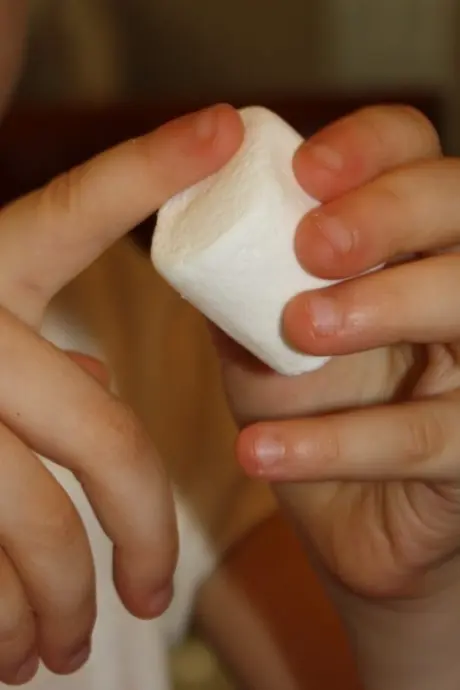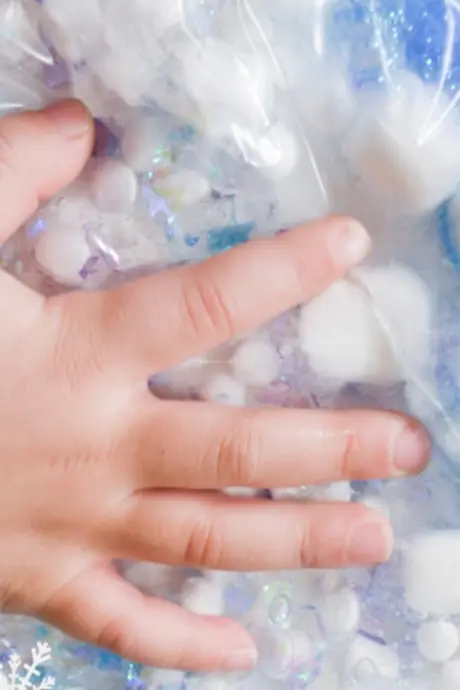settings
children
With Famly since
1. Frozen Dinosaur Eggs Sensory Play

The sensory play idea: Frozen Dinosaur Eggs Sensory Play by The Imagination Tree
In a nutshell: The slippery, cold ice provides hours of amusement when there are treasures trapped inside. Children use their own sense of invention to speed up the melting process and retrieve the dinosaurs.
What you need:
- Balloons
- Miniature dinosaur figures
- Water
- Glitter
How you do it:
Stretch a balloon over each dinosaur, capturing it inside. Fill the balloon with water and tie it off. Repeat this a few times to create a number of “dinosaur eggs”. Add glitter to the water for extra sparkle, if you like.
Place the balloons in the freezer until they’re frozen solid. Peel back the balloon latex once they’re ready and arrange them in a “nest”, which can be as simple as an open basket.
2. Easy Fluffy Slime With Saline Solution

The sensory play idea: Easy Fluffy Slime with Saline Solution by Little Bins and Little Hands
In a nutshell: A borax-free fluffy slime that’s ooey-gooey and super stretchy. Children can experiment with the weight, the density, and the squishy sensations. The bonus? It’s almost guaranteed mess-free.
What you need:
- 1/2 cup of white washable school glue
- 3 cups of foaming shaving cream
- 1/4-1/2 tsp of baking soda
- Food colouring
- 1 tbsp of saline solution
- Bowl, spoon, measuring cups and spoons
How you do it:
Simply combine all of the ingredients in a mixing bowl, starting with the shaving cream, the food colouring, and then adding the baking soda and the saline solution. Caution children against tasting this substance. In science terms, it’s called a non-Newtonian fluid, meaning it exists somewhere in between.
3. Mess-Free Water Bead Sensory Bag

The sensory play idea: Mess-Free Water Bead Sensory Bag by Parenting Chaos
In a nutshell: This activity is designed to keep little ones stimulated while you tackle the clean up after the previous messy and sensory play activities. The bright colours offer visual stimulation that will captivate and amuse young toddlers.
What you need:
- Dyed water beads
- Sandwich bag
- Heavy duty tape
- Window squeegee
How you do it:
Ensure your window is clean. Fill the sandwich bag with the water beads. It’s important to squeeze out any extra air so that there is nothing but the water beads in the bag.
Tape the bag to the window, making sure the tape doesn’t catch any of the beads. The final product is a bright and colourful bag of squishy balls. Bring the little ones and prepare for amazement.
4. Slow-Motion Calming Sensory Bottle

The sensory play idea: Slow Motion Calm Down Sensory Bottle by Childhood 101
In a nutshell: This mesmerising sensory bottle is like a hand-held starry sky, that captives the eyes and holds the attention. It can be used to help children self-regulate during episodes of emotional overstimulation.
What you need:
- Clear hair gel
- Warm water
- A tall bottle
- LEGO 2 stud bricks (or any toys that are a similar size)
- Fine glitter
- Glue or tape to secure lid (optional)
How you do it:
Combine 1 cup of hair gel with 6 cups of warm water. As it cools the gel will settle. Once this happens, pour the mixture into the bottle. Add in the glitter and few toys, like LEGO blocks, to demonstrate the slow-motion movement qualities. Top it up with more gel/water mixture.
Test it – if the toys fall too quickly, add more hair gel to thicken it, or more water to thin the consistency. Use the glue to seal the bottle once you are happy with the result.
5. Rainbow Sensory Play

The sensory play idea: Rainbow Sensory Play by Happily Ever Mom
In a nutshell: It’s edible, it’s colourful, it’s a super-tactile sensory texture. It’s rainbow breadcrumbs — and babies and toddlers love it.
What you need:
- 2 loaves of cheap bread
- Food colouring, or other non-toxic dye
- Milk or milk substitute
- Food processor
- Oven
How you do it:
Create the crumbs by placing the bread in a food processor. Colour it by adding food colouring to milk, and mixing the crumbs with the milk. Bake the crumbs to get them crispy. To make different colours, repeat the same process using a different colour each time.
6. Fruity Cheerio Activity

The sensory play idea: Fruity Cheerio Activity by Hands On As We Grow
In a nutshell: There are many ways to enjoy cheerios. A number of them offer children a sensory delight and a fun activity. Edible activities enable younger children to participate too, especially if they are still in the phase where exploration and tasting go hand-in-hand.
What you’ll need:
- Craft lace or yarn
- Cheerios, Froot Loops or similar ring-formed cereal
How you do it:
Start by tying the first cheerio onto the craft lace. It acts as a knot, which will prevent the next few cheerios from pushing that one off. Next, hand the lace and the cheerios to the children. Show them how to thread the cheerios onto the lace. Younger children will need help from time to time.
When the lace is about halfway full with cheerios, tie the two ends together, creating a necklace. Let the children decide whether they want to wear the necklace, or eat it.
7. Exploring Marshmallows with the Five Senses

The sensory play idea: Exploring Marshmallows with the Five Senses by Fantastic Fun and Learning
In a nutshell: Marshmallows are soft and powdery when they are dry, slimy when they’re wet and wonderfully squishy. Explore these sweets with all 5 senses to help toddlers grow awareness of their various sensory abilities.
What you need:
- Water
- Tray or tub
- Marshmallows
How you do it:
Start with sight. Give each child a marshmallow and have them examine it closely. What colour is it? Does it look shiny or powdery? Pull it apart and observe the stickiness.
Next, squeeze the marshmallow and listen for any sounds. Then, explore the tactile sensations of a dry marshmallow. Pull it apart, squeeze it, and then wet it. Have the children observe the differences. Lastly, enjoy the taste and give the children good words to describe the taste.
8. Winter Sensory Bin Activities

The sensory play idea: Winter Sensory Bin Activities by Mommy’s Bundle
In a nutshell: A polar landscape diorama sets the scene for children to get creative and explore the textures and colours of the toys within.
What you need:
- Cotton balls
- Styrofoam pieces
- Cotton blanket/pretend snow
- Blue tissue paper
- Blue gems or marbles
- Decorative snowflakes
- A shallow storage bin
- Arctic toy animals
How you do it:
It’s a basic assemble-and-it’s-done project. Simply add the cotton balls, the styrofoam balls, the blue tissue, and all of the other bits and pieces to the storage bin. Mix the items so that they are equally dispersed.
Keep the spoons and the other scooping materials aside to make it easier for your little one to reach them. The variety in texture and shape makes every “find” surprising. By introducing tools like scoops and spoons, you’re encouraging the use of fine motor skills, too.
9. Ice Painting with Salt

The sensory play idea: Ice Painting with Salt by Parenting Chaos
In a nutshell: This sensory activity provides children with an insight into the change of seasons as winter’s ice melts into spring. Plus, there are so many sensory opportunities in this activity, it’s irresistible. There is the solid ice, the ice that reacts to the salt which becomes slushy, the grainy texture of the salt, and, of course, all of it is ice cold.
What you need:
- Ice tray
- Paint brushes
- Watercolours
- Table salt
- Water
How you do it:
The goal is to melt the ice cubes. First, have your little one apply salt to the ice cubes. Next, help them to add glitter and paint (for fun) to the top of the salt and ice cubes. Doing this part together helps to develop coordination and fine motor skills because the ice cubes are very slippery and both hands are needed at any given time.
10. Winter Sensory Bag

The sensory play idea: Winter Sensory Bag by A Little Pinch of Perfect
In a nutshell: This activity is the perfect mess-free sensory play idea. It’s stimulating because young ones can push, pop, and squish the items inside the bag.
What you need:
- Cheap clear hair gel
- Glitter
- Plastic bag
- Marshmallows
- Cups or scoops
- Uncooked tapioca pearls
How you do it:
Add all of the ingredients to the bag and seal it. It’s that simple. The gel acts as a colourful semi-liquid suspension fluid. It’s the magic ingredient for this exercise. Place the sensory bag in the fridge in summer for a cool sensory experience.
The big ideas
Please note: here at Famly we love sharing creative activities for you to try with the children at your setting, but you know them best. Take the time to consider adaptions you might need to make so these activities are accessible and developmentally appropriate for the children you work with. Just as you ordinarily would, conduct risk assessments for your children and your setting before undertaking new activities, and ensure you and your staff are following your own health and safety guidelines.
Get 1000s of free EY activities
Want over 7,000 activities? See them in a free 14-day trial. Filter to target learning areas, age groups and topics, and get inspired.
Get started








